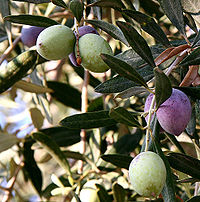
Photo from wikipedia
Feasibility and stability were evaluated of a continuous multi-batch process for converting oleuropein (OLE) from olive leaf extract to the bioactive product hydroxytyrosol (HT). Carrier beads made of three different… Click to show full abstract
Feasibility and stability were evaluated of a continuous multi-batch process for converting oleuropein (OLE) from olive leaf extract to the bioactive product hydroxytyrosol (HT). Carrier beads made of three different materials (calcium alginate, chitosan with deacetylated α-chitin nanofibers (DEChN), or porous ceramic) were investigated for morphology, thermogravimetric, sorption, and viscoelastic properties. Enzymatic hydrolysis of OLE conducted in a packed bed bioreactor containing cellulase immobilized to carrier beads yielded OLE degradation rates of ~ 90% and an average HT yield of ~ 70% over 20 batches. Ultimately, inorganic porous ceramic beads were less costly and exhibited superior performance relative to organic carriers and thus were deemed most suitable for industrial-scale HT production. Systems utilizing enzyme immobilization within packed bed reactors hold promise for achieving efficient production of valuable bioproducts from discarded biomass materials.
Journal Title: Applied Biochemistry and Biotechnology
Year Published: 2019
Link to full text (if available)
Share on Social Media: Sign Up to like & get
recommendations!